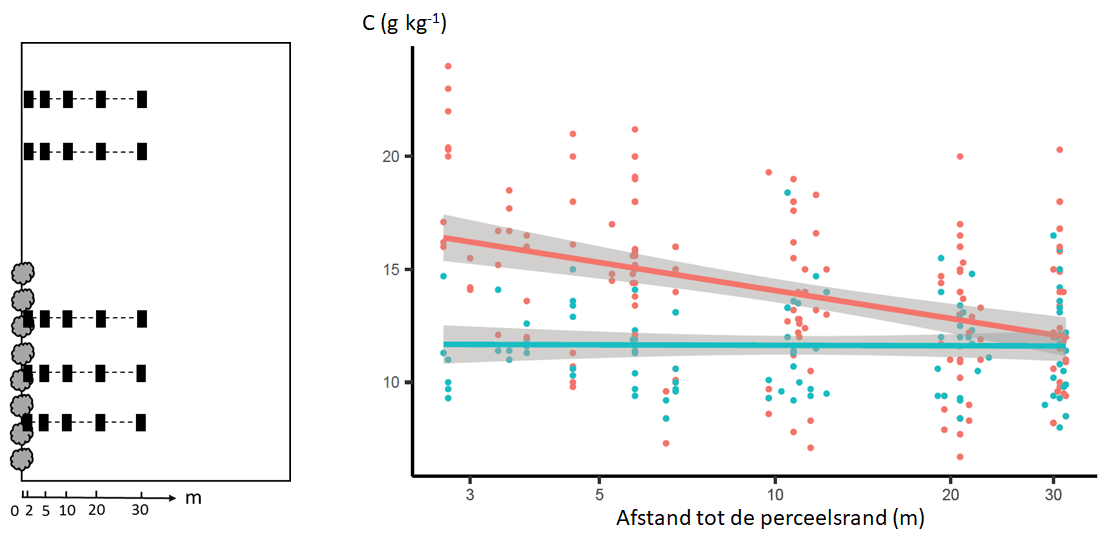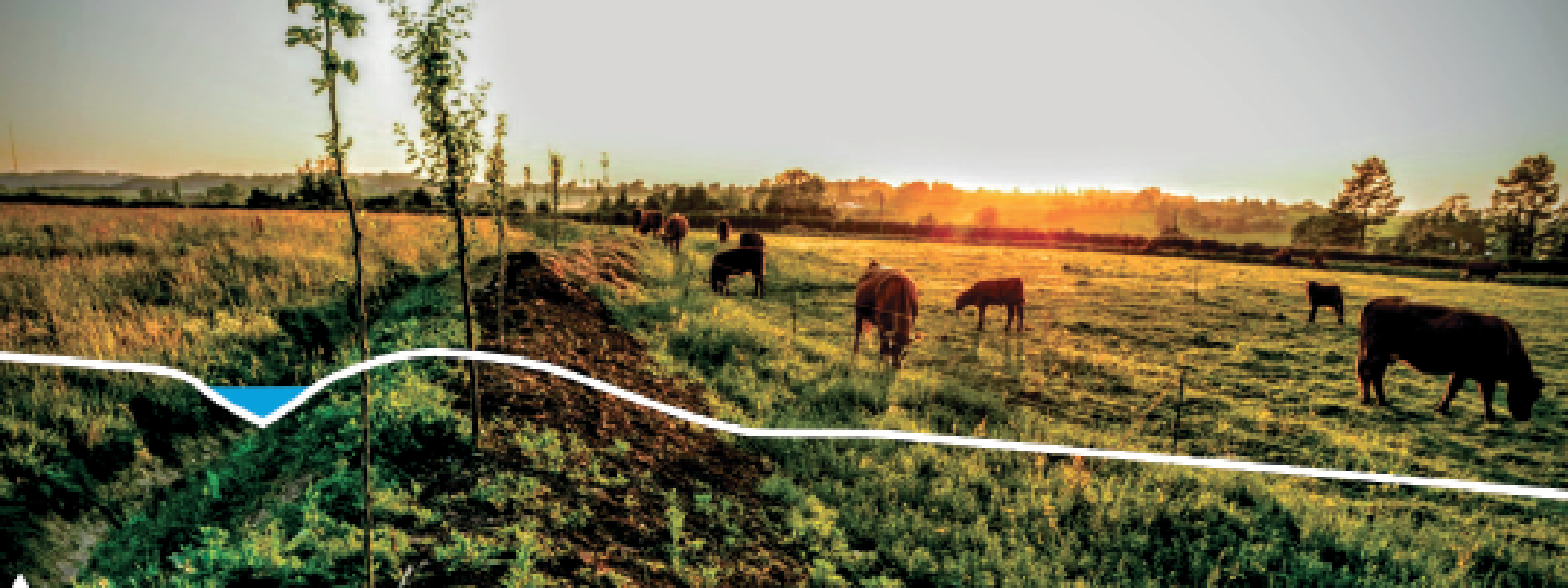Climate mitigation and adaptation
Introducing trees in the field or pasture affects the soil, water balance, (micro)climate, biodiversity, other ecosystem functions in the short or longer term. You can also read more about these effects in this information sheet.
In the same way, agroforestry has an impact on climate mitigation (mainly via carbon storage) and climate adaptation (mainly via changes in microclimate, water balance and erosion reduction).
Conversely, a changing climate also affects the performance of agroforestry systems themselves, and also, for example, tree species choice.
Climate mitigation
Carbon storage in the soil and in biomass
Trees can make an important contribution to increasing soil organic carbon as well as storing carbon in the biomass of the trees themselves (above ground and below ground).
In order to know exactly how great the effect on soil carbon content is for agricultural plots in our region, soil carbon stocks were determined in 2015 and 2016 on 11 arable plots with relatively mature tree rows (15- to 47-year-old poplars (Populus x canadensis) and an average age of 25 years) in Belgium. Here, an average increase in organic carbon of 5.3 tons/ha was found in the building soil (0-23 cm depth), at a distance between 2 and 30 m from the poplar rows, compared to a control zone without a tree row (see figure). This corresponds to an average increase of 0.21 tons C/ha/year, which is in line with results from the literature from France and Canada. Measurements on young agroforestry plots (tree age 3-5 years) showed that this effect is not yet observable in the first years. The increase next to older trees is mainly explained by input of organic matter through leaf fall, and to a lesser extent by branch fall. In principle, decomposition of fine tree roots may also contribute to this. However, this effect is assumed to be limited since tree roots in agroforestry systems tend to seek the deeper soil layers to avoid competition with the crop and because these layers are less or not disturbed by field operations. Although no measurements were made on grassland plots, foreign research indicates that agroforestry can also contribute to carbon accumulation here.

Simulating carbon storage in agroforestry systems with the tool CARAT
Although the above figures refer only to the carbon stock in the building stock near poplar rows, they quantify a very specific situation. Moreover, storage in the biomass of the trees themselves is not included here. Total carbon storage in agroforestry systems is very situation specific and consequently difficult to generalize. This includes the effect of tree density, tree species, tree age and soil management.
The Soil Science Service of Belgium, ILVO and Fornalab - UGent, all partners of the Consortium Agroforestry Vlaanderen, therefore developed the carbon calculation tool CARAT. Using this tool, a better estimate can be made of the expected carbon storage in the trees and in the soil of a specific agroforestry plot over time. This takes into account, among other things, the selected tree species(s), planting distances and soil type.
More info on this tool can be found here.
Climate mitigation
Water
An important condition for a high-performing agroforestry system is that the trees primarily tap soil water and nutrients that would otherwise not be used by the agricultural crop, or contribute positively to increased water availability themselves. Field research on agroforestry systems has recently been on the rise, but research quantifying the interaction between trees and crop in terms of water uptake is currently limited, especially in temperate climates.
Trees can exert a significant influence on soil moisture content through their root systems. Especially where water availability is limited during the growing season, trees and the crop can compete for water, previous research has shown. On the other hand, the trees can also just provide higher water availability for the crop because the tree roots absorb water from deeper soil layers and release it back near the surface. Also, due to their shade throw and the creation of a microclimate (see below) with higher humidity, evapotranspiration near the trees can decrease, keeping the soil moisture content higher. Finally, preferential runoff of rainwater along the tree trunk can also cause the soil moisture content near the trees to increase.
Our research on the impact of agroforestry on water resources is in full development.
Among other things, we are focusing on this topic in the European projects DIGITAF en AFAKTIVE.
Some initial observations? See also this project report on the impact of agroforestry on water resources.
Microclimate
The presence of trees in the field further affects temperature as well as wind speed, direction and turbulence. Therefore, trees are often considered and planted as a buffer against extreme temperatures or as a windbreak.
Windbreak
Individual standard trees, but especially line-shaped hedges, hedgerows and wood edges can be planted as a windbreak. Especially in open areas, e.g. the polder plains in Flanders, these can play an important role. For example, reducing wind speed reduces the rapid drying out of soil and crop and reduces wind erosion and/or alloying of the crop, which can lead to higher yields on larger plots themselves. But a windbreak also provides better shelter for animals with outdoor runs. Certainly chickens and pigs are very sensitive to this.
The efficiency of the windbreak depends on its external structure (height, length, width, orientation, continuity and shape) but equally on its internal structure, that is, its “porosity.” This porosity is determined, among other things, by the choice of species, the spacing of individual trees, the number of rows of trees in a woodlot and/or maintenance (pruning). For example, a very dense hedge has low porosity and results in stagnant air near the windbreak, with all of the airflow being directed over the trees. In turn, a semi-open hedge or woody edge or a row of trees with undergrowth has a higher porosity, in which the air, although slowed down, is also directed to a considerable extent through the woody structure.
The size of the sheltered area behind the windbreak is proportional to its height. The shelter can be noticeable up to a distance of 4 to 30 times the height of the windbreak, depending on the porosity.
Insufficient continuity in the windbreak, e.g., the presence of gaps in a wood edge, can lead to (undesirable) air turbulence as air concentrates and accelerates in those gaps.
Finally, the efficiency of the windbreak is usually greatest when planted perpendicular to the dominant wind direction, unless there are good reasons for a different orientation, e.g., when one specifically wants to temper a cold north wind in fruit production.
Temperature
The shading effect of trees and altered air circulation affect the temperature of air and soil on an agroforestry plot. The French project 'Parasol' has recently looked at this in more detail, especially in view of heat stress in sheep. The conditions studied within this project are similar to those in Flanders, especially when considering the two most recent dry and hot summers.
Results indicate that at plot level, average daily temperatures do not necessarily differ in the presence or absence of trees. On the other hand, when looking in more detail at the diurnal course of temperature, one finds that trees will buffer the most extreme temperatures. At the hottest hours of the day, it is on average 3 to 6 °C cooler at agroforestry sites. At night, one observes a reverse effect, with slightly higher temperatures under the trees. Obviously, the exact effects depend on the precise conditions (tree density and age, plot location and exposure, ...). Although still to be studied further, this shows the potential for e.g. on low stem or small fruit plantations to be better buffered against night frost in spring.Soil temperature is influenced by air temperature as well as the type of cover on the soil. The presence of trees allows a faster warming at the beginning of the season and a fresher climate in the summer period.
Want to read more? Check the website of the project AForClim.
Erosion
On sloping and erosion-prone plots, agroforestry has strong potential to reduce erosion problems both above ground (through the permanent vegetative structure under the trees or rows of trees) and below ground (through rooting and improved soil structure). In particular, such rooting and soil life play a crucial role, creating a network of channels through which runoff water can infiltrate. In the same way, the water storage capacity of the soil increases.
Many social costs can thus be reduced: think of the consequences of flooding, but also the disposal of silt that ends up on bicycle paths and roads, in ditches and rivers, gardens and even houses.
Of course, the extent to which agroforestry will actually contribute to erosion reduction depends strongly on the orientation of the tree rows, the choice of tree species, but especially on the interpretation and management of the undergrowth in the tree strip.
One particular form of agroforestry that takes strong advantage of the erosion control function is the application of “contour forestry. This term refers to systems where agroforestry is done according to a line-shaped design and where the lines follow the contours of the landscape or plot. An application of this can be interesting to distribute and infiltrate precipitation water evenly, avoiding overly wet valleys and dry ridges. Besides avoiding erosion, this results in a substantially greater storage capacity of water in the soil, which can be a particular asset in times of prolonged drought. The basis for this system is formed by the construction of so-called swales or ditch-berm structures on the plot. A swale consists of a ditch to collect water, followed by a small berm or earth embankment downhill right next to it. In contour forest agriculture, perennial woody vegetation is then planted on that berm. We repeat: crucial here is that the swales are laid out parallel to the contour lines.
In the ditch, runoff water is collected and can then infiltrate into the soil. This also allows the sediment and nutrients present in the water to infiltrate and not enter surface water, where they would contribute to eutrophication. Downstream of a swale, the flow rate of runoff water will be lower, resulting in less erosion. Swales may also be constructed so that excess water is diverted to a reservoir where it remains available for later use.

Want to read more? Read this projectrapport ‘contourboslandbouw’ on the website of Agroforestry Vlaanderen.
We continue zooming in on this topic within the project AFAKTIVE.
Tree species selection in a changing climate
Climate change has also been increasingly felt in Flanders in recent years: prolonged droughts and heat waves are becoming more frequent. As a result, tree species selection is not an easy task. Indeed, it is becoming increasingly certain that such droughts and heat waves will become more frequent in the future. However, it is difficult to predict their long-term effects on tree species.
In this article (Dutch), we present a number of tree species that, according to scientific literature and field observations, are very likely to remain suitable for Flanders, with a view to agroforestry. We focus on tree species that are capable of developing a continuous trunk and thus suitable for high-value applications.
